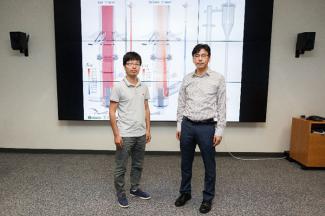Multiphase flow research examines the way materials in different states like gas, liquid or solids with different chemical properties mix and flow together. Multiphase flows occur in most commercial energy and environmental processes, and understanding the interaction among these phases is critical to understanding and predicting the performance of many energy system devices. It’s a complex area of investigation but one which holds the key to unlocking advanced energy applications like using biomass feedstocks in energy-producing reactors. NETL, along with a team of researchers from other DOE National Laboratories, is on the task.
Biomass is an energy source from plants like wood, food crops, agriculture or forestry residues, algae or even fumes from landfills. But much work remains to find the most efficient ways to use biomass as an energy source. That’s why NETL researchers are applying their skills in multiphase flow to help design systems to effectively unlock energy from this renewable feedstock.
NETL’s expertise in multiphase flow research makes the Lab a key partner in the Consortium for Computational Physics and Chemistry (CCPC)—a joint research and development effort involving five DOE national laboratories on a mission to accelerate the discovery and deployment of novel materials that can assist in the scale-up of commercial operations that use biomass feedstocks to produce energy.
Using DOE’s state-of-the-art computational modeling facilities, CCPC work facilitates the modeling of biomass industrial technologies from the atomic scale to full process scale, reducing the cost, time, and risk in commercializing bioenergy technologies. Within CCPC, NETL is working with Oak Ridge National Laboratory (ORNL) and the National Renewable Energy Laboratory (NREL) to pinpoint processes that can be scaled up to achieve enough efficiency to be economically sustainable.
The NETL, ORNL, and NREL collaboration specifically centers upon reactor analysis. Reactors are vessels specifically designed to contain the chemical reactions from plant-based feedstocks that release energy.
According to NETL’s Tingwen Li, Ph.D., who serves as the lead modeler on CCPC project, the complexity of biomass feedstocks is very high and it is very difficult to fully capture in “low-order” models—modeling with simplified approximations of flow and chemistry in complex reactors. That’s where NETL’s multiphase flow expertise plays an important role.
Li explained that NETL work helps develop “high-order” models that capture full or near full complexity of biomass reactors to provide insights into performance issues. Li is working closely with NETL Post-doctoral researcher. Xi Gao, Ph.D., to perform an extensive validation and application efforts that study various biomass processes supporting the CCPC project. NETL multiphase experts and CCPC team members at other laboratories are using NETL’s MFIX Suite of multiphase flow modeling software to address challenges.
One example of the many aspects involved in the efficient use of biomass feedstocks is NETL’s support of the modeling of fast pyrolysis and other processes where valuable biomass products are produced for energy or chemical feedstocks. Pyrolysis is the thermochemical decomposition of organic material at elevated temperatures in the absence of oxygen.
High-order models are also being used to understand the complex flow patterns that occur in fluidized bed reactors—a type of reactor sometimes used for extracting energy or valuable products from biomass feedstock. Fluidized beds occur when gas or liquid is passed through particle beds at high velocities to suspend the solid and cause it to behave as though it were a fluid. The results of these models are used to optimize yields and to understand safe operating regimes for fluidized bed reactors.
NETL’s work is important to CCPC activity because the data produced from its modeling work in the multiphase flow arena produces information that is more extensive than that generated by experiments alone.
The CCPC research program—with NETL’s help— is designed to help adapt technology design early in the development stage to control costs and reduce risks of commercial development.
NETL’s William Rogers, who is coordinating the CCPC support activities in the NETL Multiphase Flow Analysis Laboratory, said, “Adapting new technology for proper commercial deployment could take up to 15 years and another 20 years for widespread industrial-scale use,” he said. “Also, there are estimates that 75 percent of the cost of manufacturing is committed at the design stage. Computational modeling like we do with multiphase flow research, help control costs and risks to reduce those times.”
The multiphase flow research on biomass feedstocks and reactors, and the collaboration with other National Laboratories through CCPC, is an example of how NETL works to discover, integrate, and mature technology solutions to enhance the nation’s energy foundation and protect the environment for future generations.




